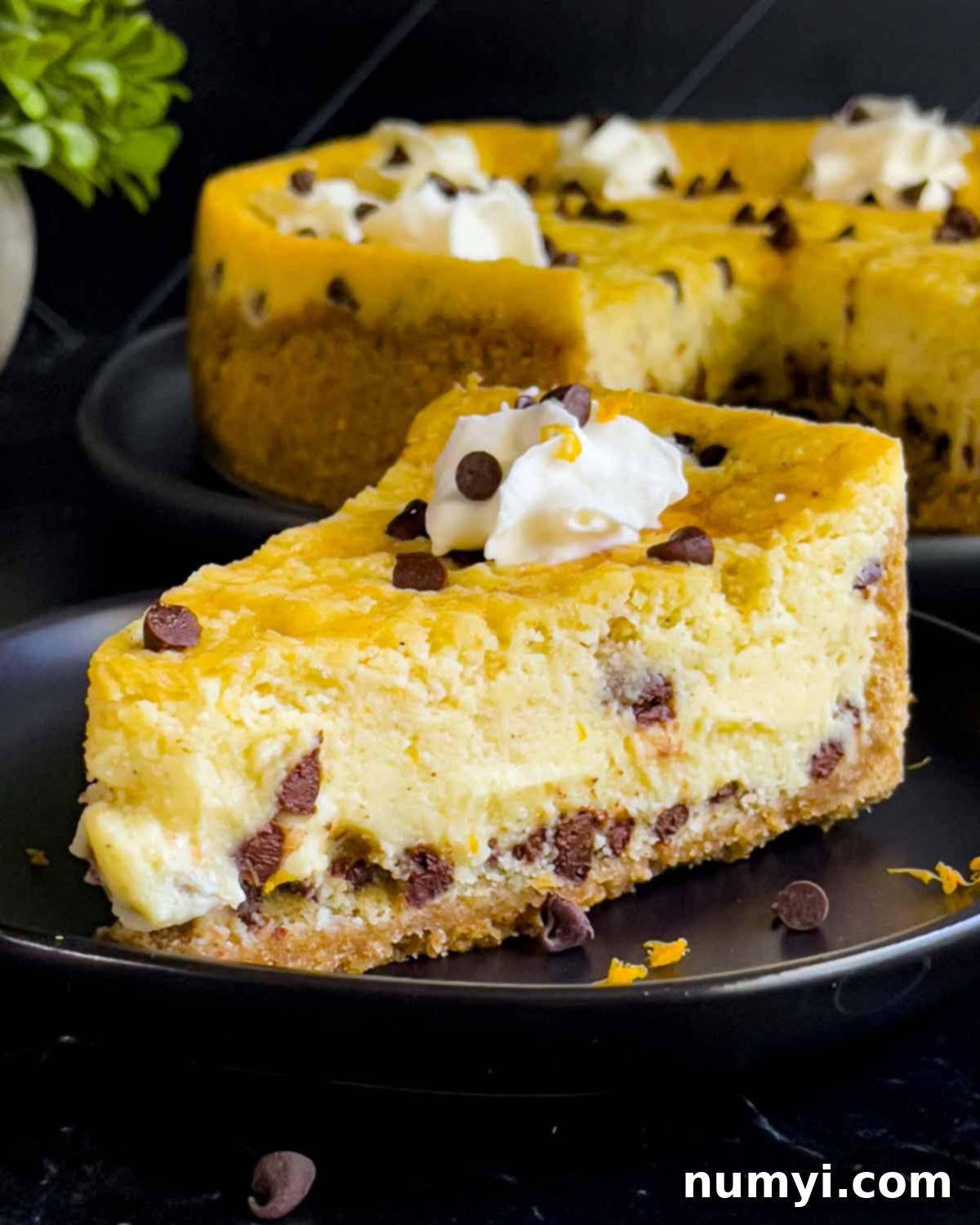Decadent Cannoli Cheesecake: An Italian-Inspired Mascarpone & Ricotta Delight
Embark on a culinary journey to Italy with this extraordinary cannoli cheesecake recipe, a rich and decadent dessert that seamlessly marries the beloved flavors of traditional Italian cannoli with the luxuriously creamy texture of a mascarpone and ricotta cheesecake. This isn’t just another cheesecake; it’s a sophisticated twist on two classic desserts, offering a symphony of textures and tastes that will enchant your palate and impress your guests. Imagine the crispy, spiced shell of a cannoli, but transformed into a smooth, velvety, and utterly irresistible cheesecake.
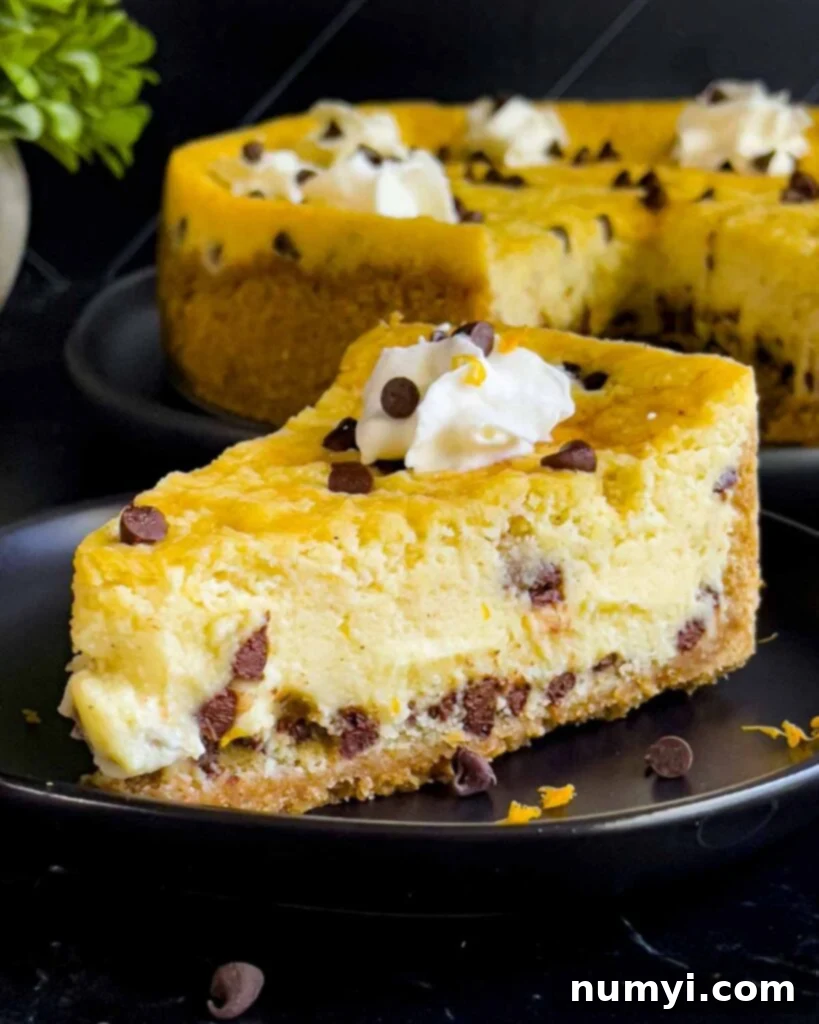
Don’t Sweat The Recipe is supported by its readers. We may earn a commission if you purchase through a link on our site. Learn more.
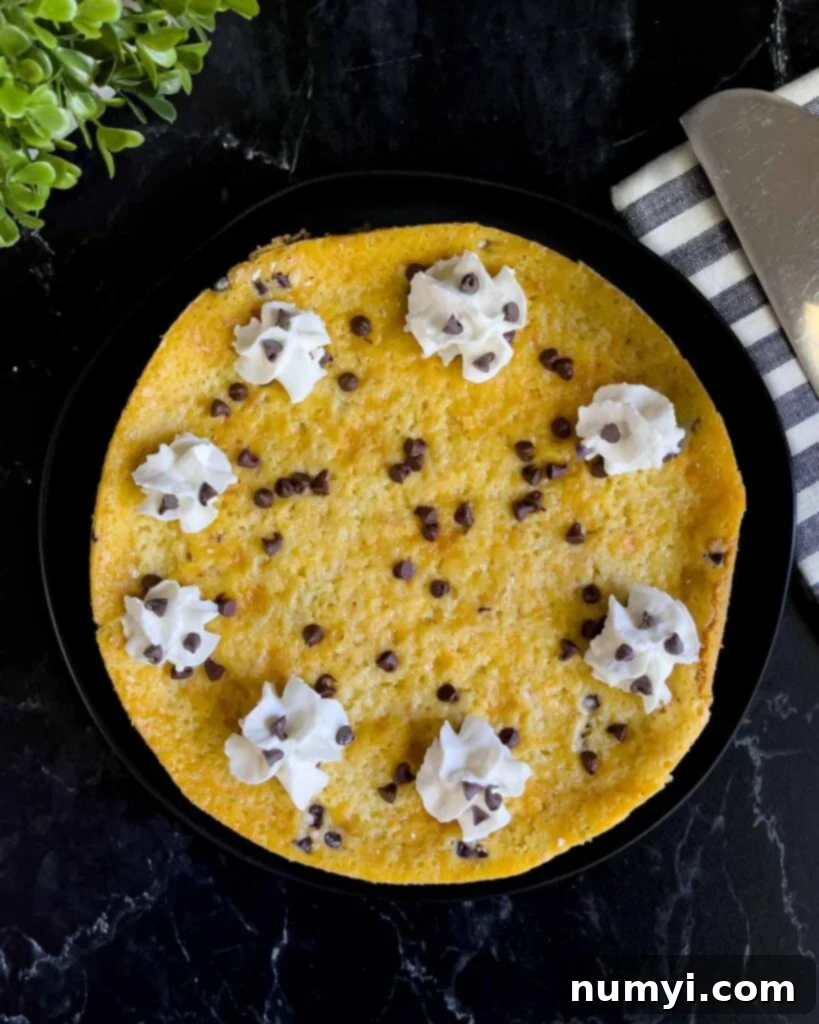
Why You’ll Love This Cannoli Cheesecake Recipe
This cannoli cheesecake recipe isn’t just a dessert; it’s an experience. Here’s why it will quickly become one of your favorite treats:
First and foremost, it’s an incredibly easy yet elegant dessert, perfect for any occasion. Whether you’re hosting a sophisticated dinner party, celebrating a special holiday, or simply indulging in a weekend treat, this cheesecake effortlessly transitions from casual to gourmet. Its impressive appearance belies the straightforward preparation, making you look like a pastry chef without the stress.
Secondly, it captures the authentic, traditional Italian cannoli flavor profile. With notes of rich chocolate, bright citrusy orange, and warm aromatic cinnamon, every bite transports you straight to the heart of Sicily. These classic flavors are perfectly balanced within the creamy, smooth cheesecake, offering a nostalgic taste that’s both comforting and exciting.
Lastly, this isn’t just any cannoli cheesecake recipe – it’s a meticulously tested and perfected version, guaranteeing success in your kitchen. We’ve fine-tuned every step, from the crust to the filling, to ensure a consistently delicious result that will please even the most discerning dessert connoisseurs. Its creamy texture and rich flavor combination make it an absolute crowd-pleaser that you’ll want to make again and again.
If you adore Italian desserts as much as we do, be sure to explore some of our other cherished recipes, including Italian Rainbow Cookies, Italian Ricotta Cookies, Butterball Cookies, Italian Fig Cookies, and the ever-popular Italian Love Cake.

Essential Ingredients for Your Cannoli Cheesecake
Crafting the perfect cannoli cheesecake starts with selecting the right ingredients. Below is a breakdown of what you’ll need, along with important tips for each. For a precise ingredient list and detailed instructions, please refer to the recipe card further down the page.
- Ricotta Cheese: For an exceptionally rich and creamy cheesecake, we highly recommend using whole milk ricotta cheese. This type of ricotta has a higher fat content, contributing to a smoother, more luxurious texture. Crucially, it must be drained overnight to remove excess moisture. Undrained ricotta will lead to a watery, less firm cheesecake. Our preference is the Galbani brand, as it typically contains less water, yielding superior results.
- Mascarpone Cheese: This Italian cream cheese is a cornerstone of our cannoli cheesecake. Made from cow’s milk and heavy cream, mascarpone boasts a higher fat content than typical American cream cheese, giving the cheesecake its signature velvety smoothness and rich, slightly sweet flavor. It’s essential for achieving that authentic Italian dessert profile.
- Eggs: Use large, room temperature eggs. Bringing your eggs to room temperature before mixing helps them incorporate more evenly into the batter, preventing curdling and ensuring a consistently smooth and uniform cheesecake texture. They act as a binding agent, providing structure to the creamy filling.
- Graham Cracker Crumbs: These form the classic, subtly sweet and crunchy base of our cheesecake. You have the option to purchase pre-crushed graham cracker crumbs for convenience, or you can easily make your own by pulsing whole graham crackers in a food processor until finely crushed.
- Flavorings: The unique cannoli essence comes alive with a blend of specific flavorings:
- Orange Zest: Provides a bright, fragrant citrus note that cuts through the richness and is a hallmark of traditional cannoli.
- Mini Semi-Sweet Chocolate Chips: These add pockets of chocolatey goodness and a slight textural contrast, mimicking the chocolate found in cannoli filling. Mini chips are preferred as they are less likely to sink in the batter.
- Cinnamon: A warm, earthy spice that complements the orange and chocolate, deepening the overall flavor profile.
- Vanilla Extract: Enhances all the other flavors, adding a touch of classic sweetness and aroma.
The Crucial Step: How to Properly Drain Ricotta Cheese
Draining your ricotta cheese is a vital step that cannot be skipped if you desire a perfectly textured cannoli cheesecake. Excess moisture in ricotta can lead to a soupy, less firm cheesecake that may crack during baking. Follow these simple steps to ensure your ricotta is perfectly prepared:
Start by lining a fine-mesh strainer with a large piece of doubled cheesecloth. The cheesecloth should hang over the edges of the strainer. Gently pour the entire container of ricotta cheese onto the cheesecloth. Once all the ricotta is in, fold the edges of the cheesecloth over the top of the ricotta, completely encasing it.
Next, place the strainer containing the ricotta over a bowl of similar size. This bowl will catch the liquid that drains from the cheese. To expedite the draining process and remove as much moisture as possible, place another bowl of similar size directly on top of the cheesecloth-covered ricotta. Weigh this top bowl down with something moderately heavy that fits inside, such as a few cans of food or a heavy plate. This gentle pressure helps press out the whey.
Transfer the entire setup (bowl, strainer with weighted ricotta) to the refrigerator and let it drain overnight, or for a minimum of 6 hours. You will be surprised by how much liquid accumulates in the bottom bowl!
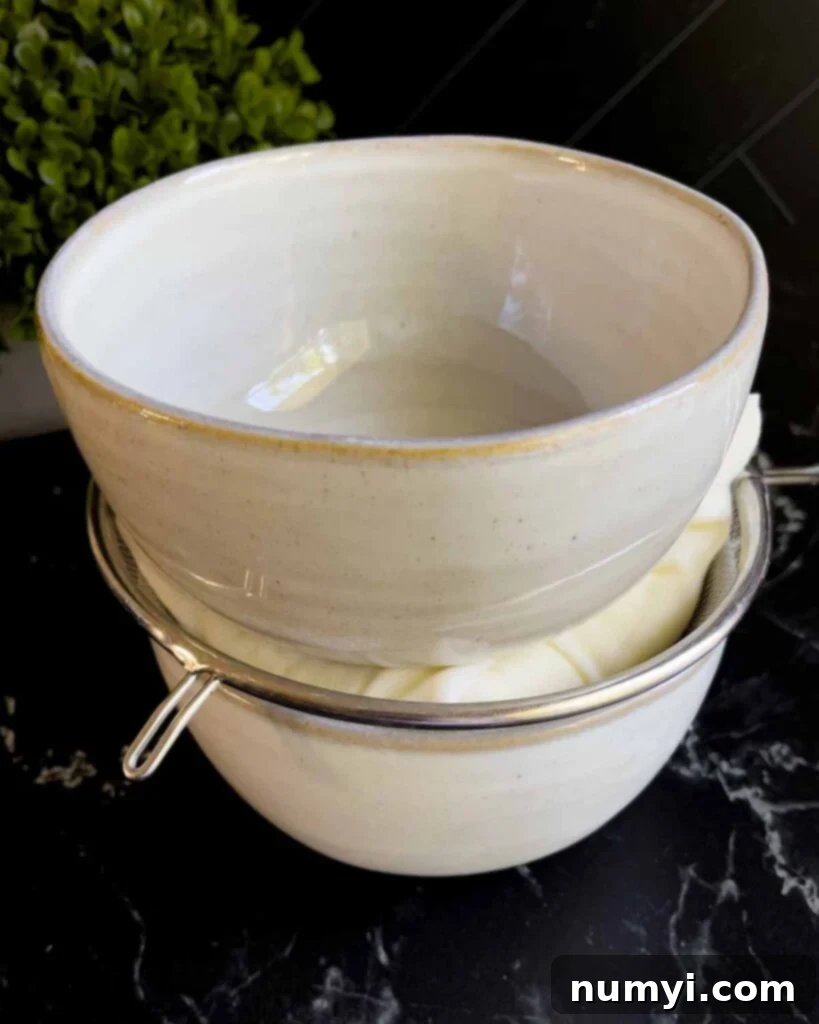
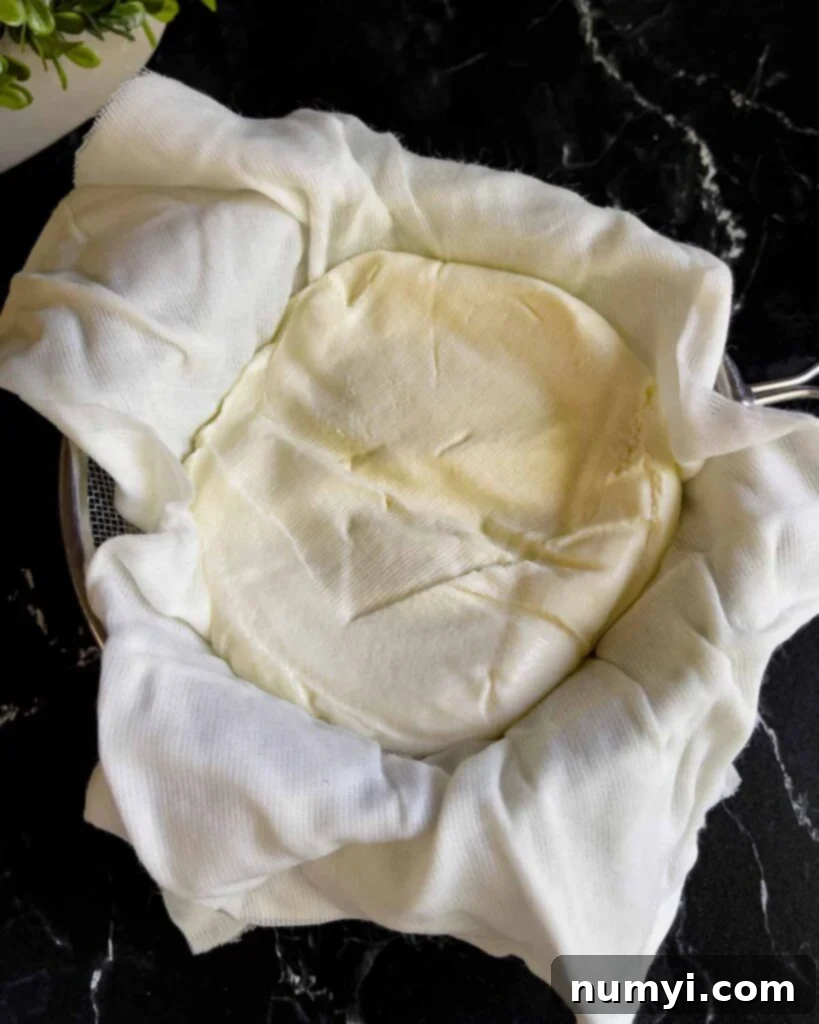
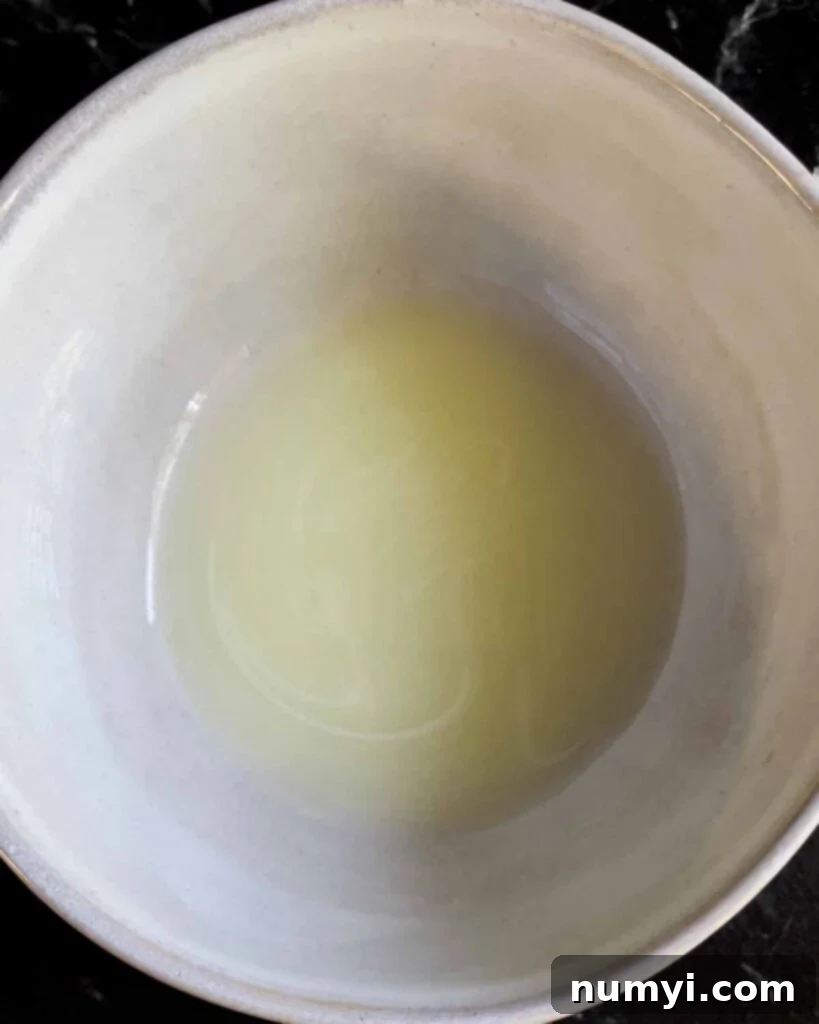
Before you begin preparing the cheesecake filling, remember to bring the thoroughly drained ricotta cheese to room temperature. This ensures it blends smoothly and evenly with the other ingredients, contributing to the perfect cheesecake consistency.
Step-by-Step Guide: How to Make Decadent Cannoli Cheesecake
Making this cannoli cheesecake is a rewarding process. Follow these detailed instructions for a show-stopping dessert.
Preparing the Crust and Pan
Begin by preheating your oven to 350 degrees F (175 degrees C). Prepare a 9-inch springform pan by generously spraying it with nonstick cooking spray. This helps prevent sticking. To ensure a waterproof seal for the crucial water bath, wrap the bottom and sides of the springform pan in a double layer of heavy-duty aluminum foil. Make sure the foil extends all the way up the sides to prevent any water from seeping into the crust or cheesecake.
In a medium bowl, combine the graham cracker crumbs, ground cinnamon, a pinch of kosher salt, and the melted unsalted butter. Mix these ingredients thoroughly with a fork until they are well combined and resemble wet sand. The butter binds the crumbs together.
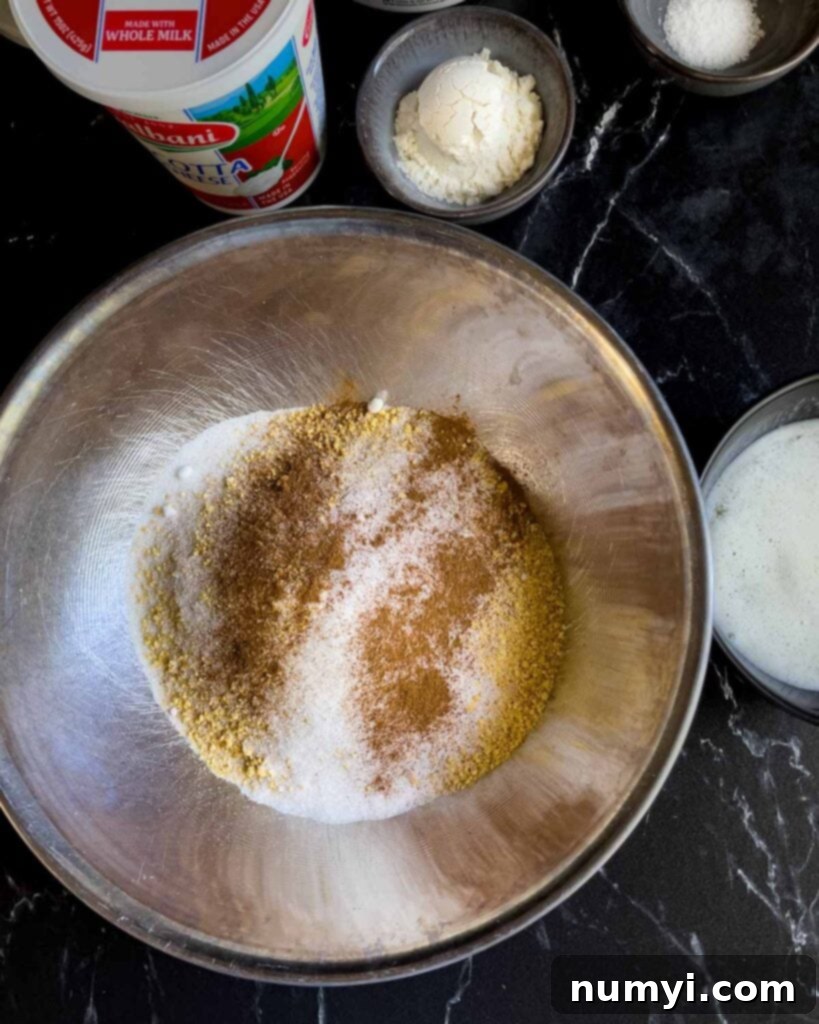
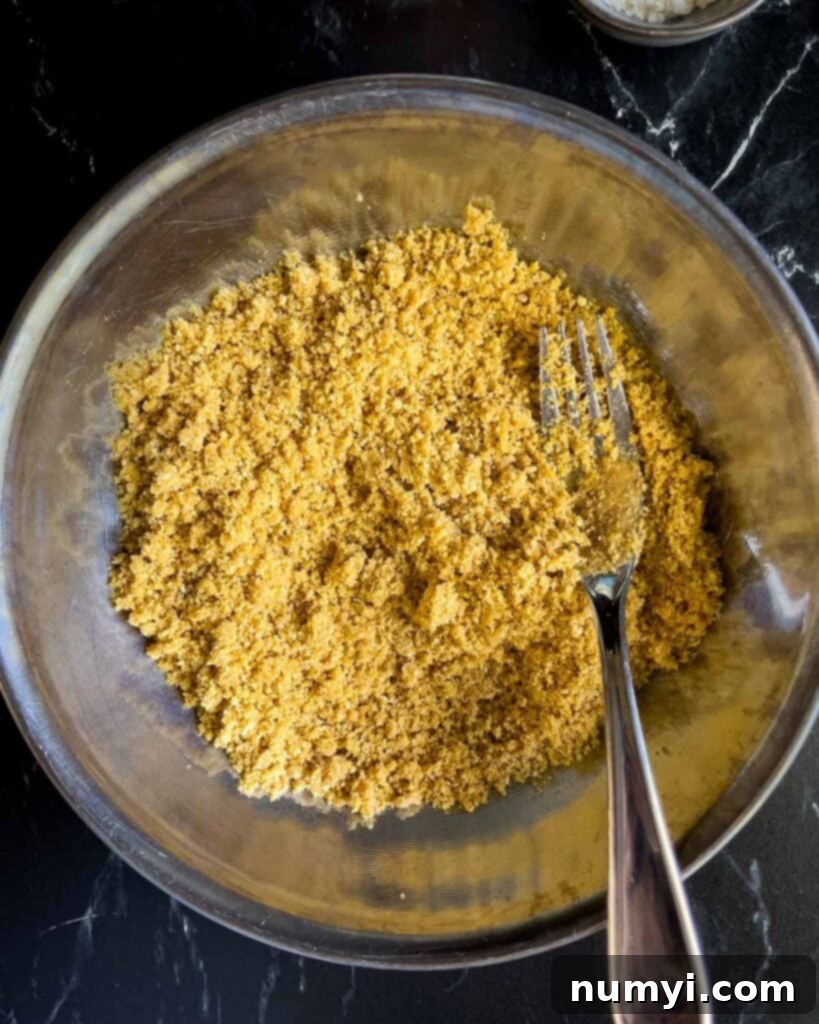

Press the mixture firmly and evenly into the bottom of your prepared springform pan. You can use the bottom of a flat glass or a measuring cup to achieve a compact and uniform crust. Bake this crust in the preheated oven for 10 minutes. Afterward, remove it from the oven and allow it to cool completely on a wire rack while you prepare the cheesecake filling. This pre-baking step helps create a sturdy and flavorful base.
Before starting the filling, ensure you have a large roasting pan ready. This pan will be used for the water bath, so it needs to be big enough to comfortably accommodate your springform pan in the center without its sides touching the outer edges of the roasting pan. This setup is crucial for even baking.
Once the crust is baked, reduce your oven temperature to 325 degrees F (160 degrees C).
Crafting the Creamy Filling
In a large mixing bowl, using an electric mixer, beat the room temperature mascarpone cheese on medium speed for about 10 seconds until it’s slightly softened. Then, add the room temperature, well-drained ricotta cheese. Continue to beat on medium speed until both cheeses are thoroughly combined and the mixture is smooth and lump-free. Remember to scrape down the sides of the bowl periodically to ensure everything is fully incorporated.
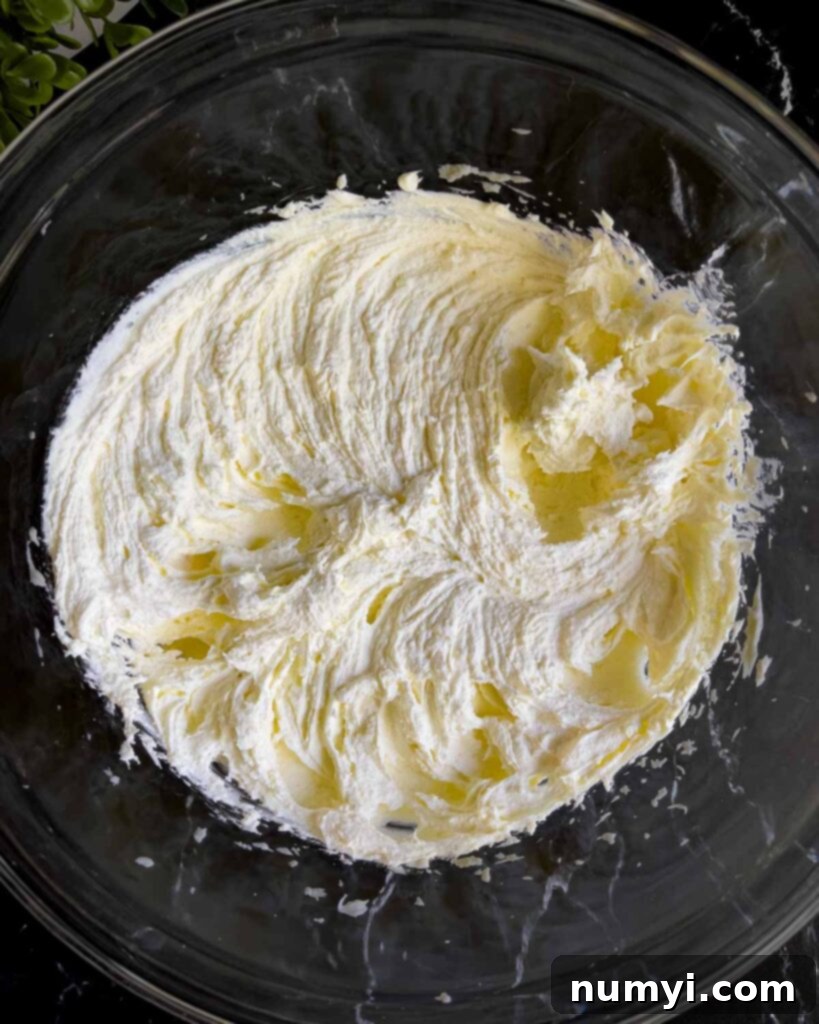
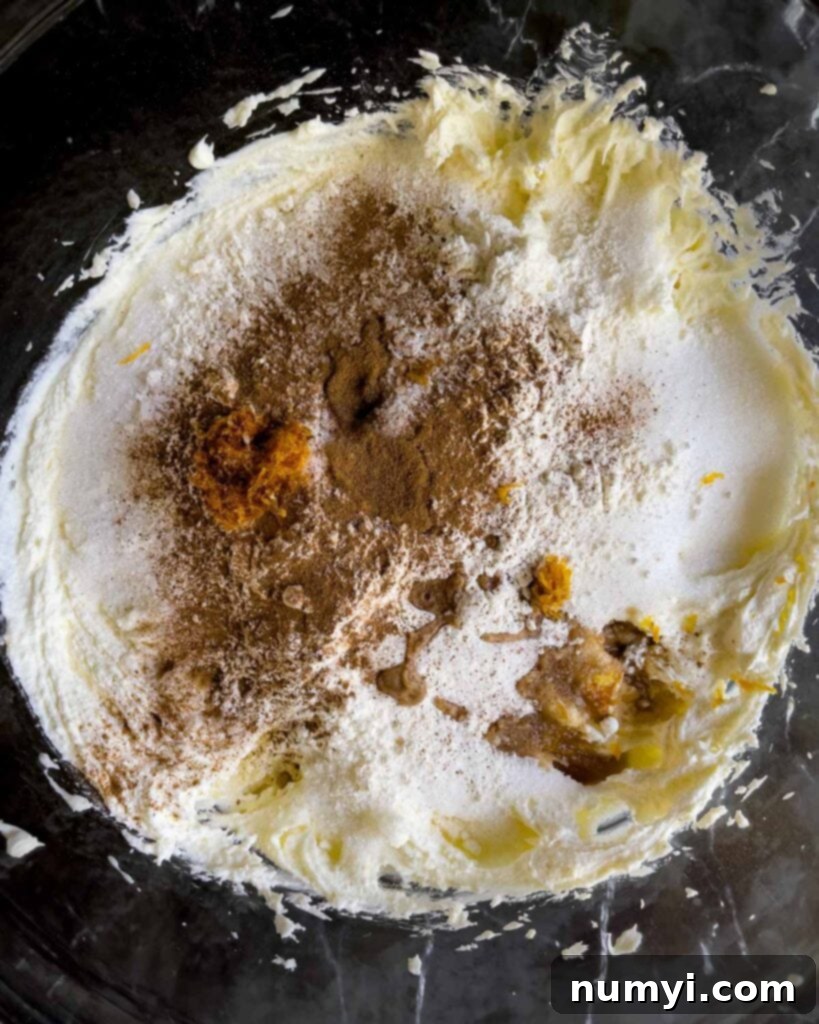
Next, add the granulated sugar, vanilla extract, all-purpose flour, ground cinnamon, fresh orange zest, and kosher salt to the cheese mixture. Beat on medium-low speed until all ingredients are well combined and the batter is smooth. Again, take care to scrape down the sides of the bowl as needed to ensure no dry pockets remain.
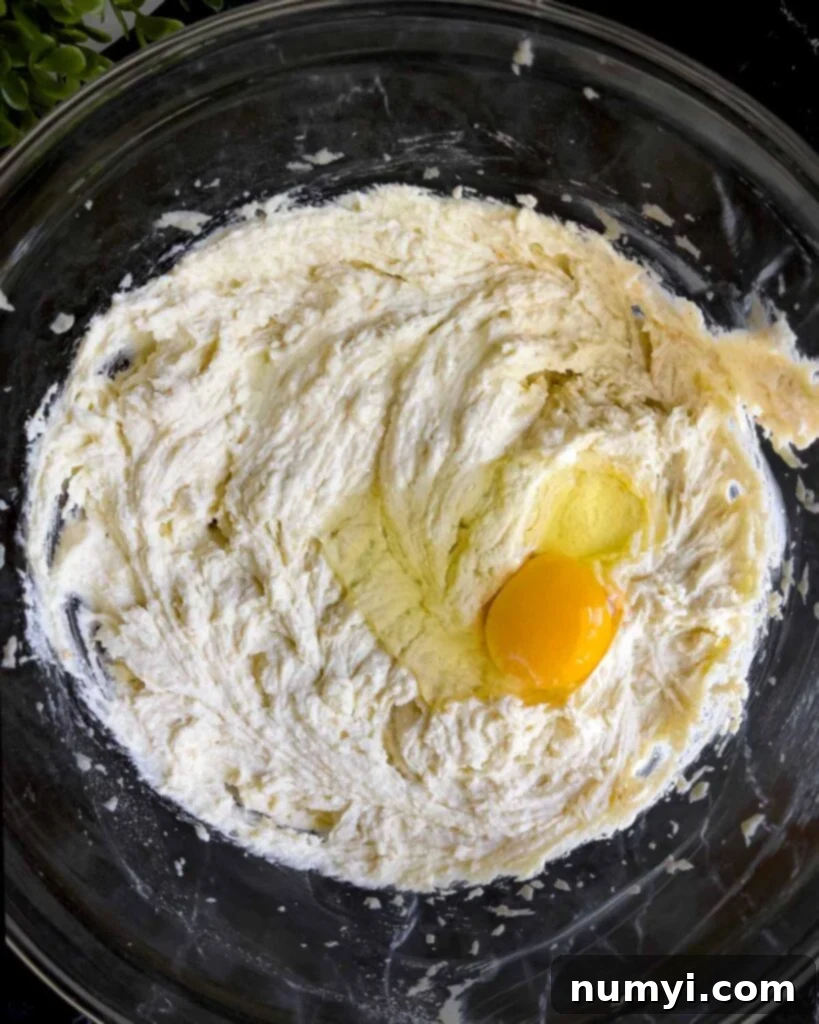
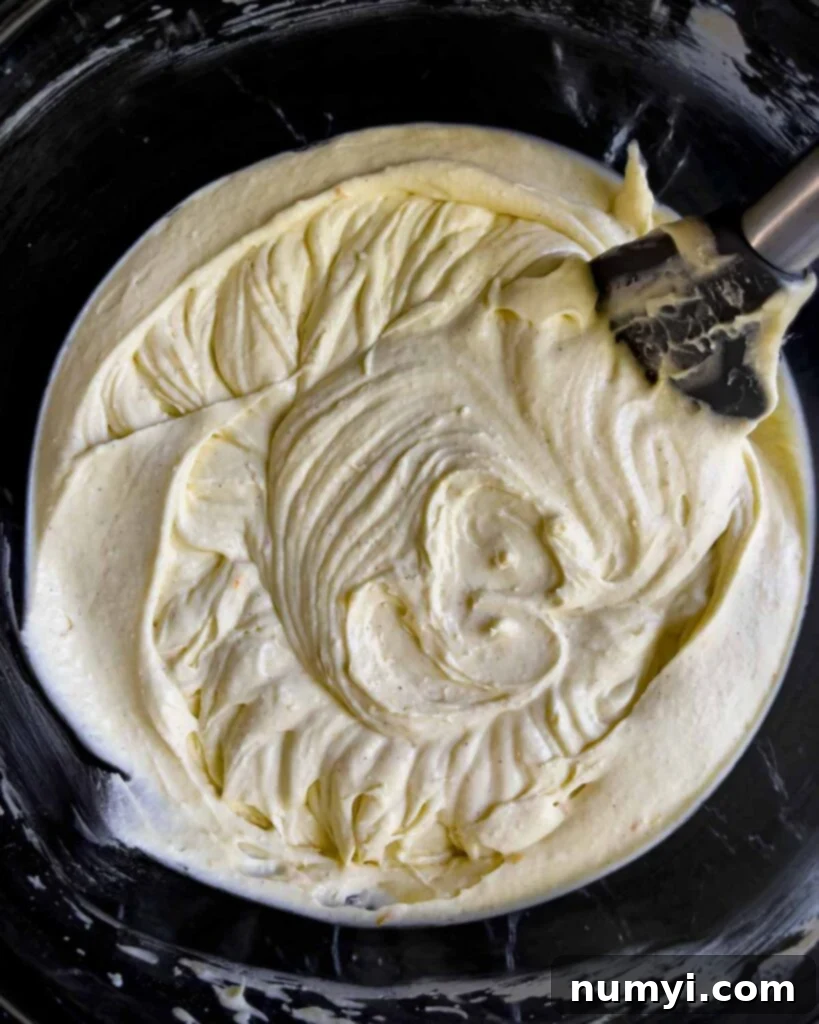
Beat the eggs into the batter one at a time, mixing until just combined after each addition. Be careful not to overmix at this stage, as too much air can lead to cracks in your cheesecake. Before adding the mini chocolate chips, toss them with the remaining 1 tablespoon of all-purpose flour. This small trick helps prevent the chocolate chips from sinking to the bottom of the cheesecake during baking. Gently fold in ¼ cup of the flour-coated mini chocolate chips.
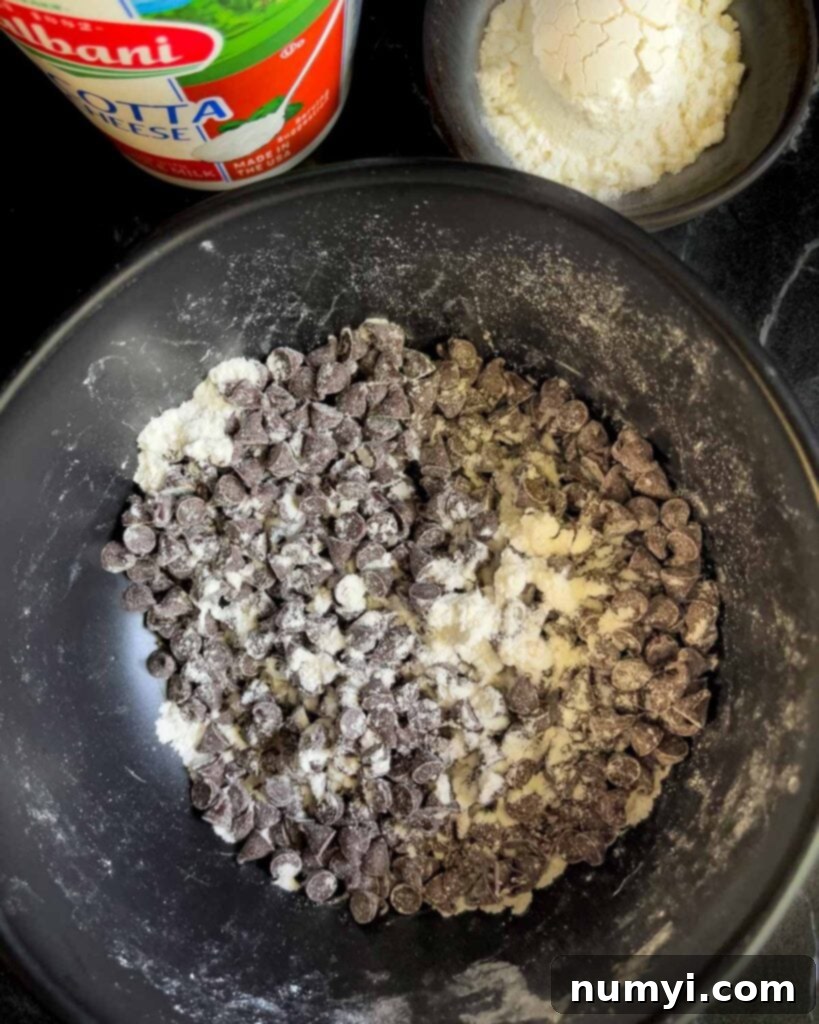
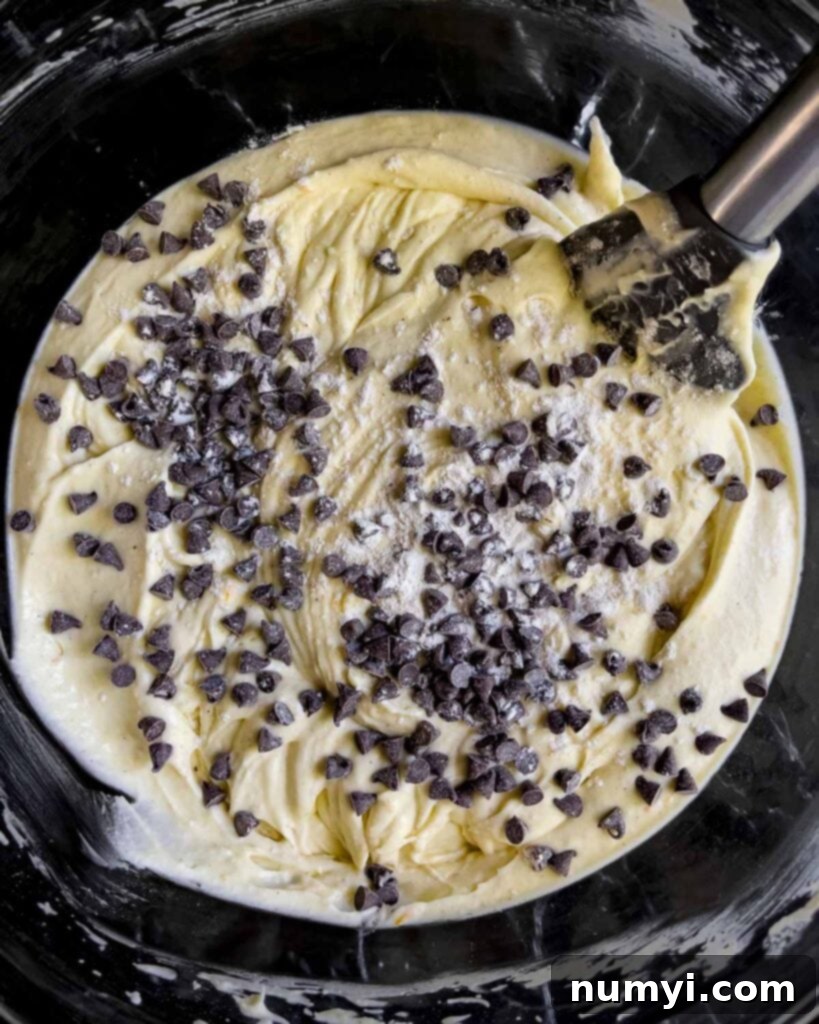
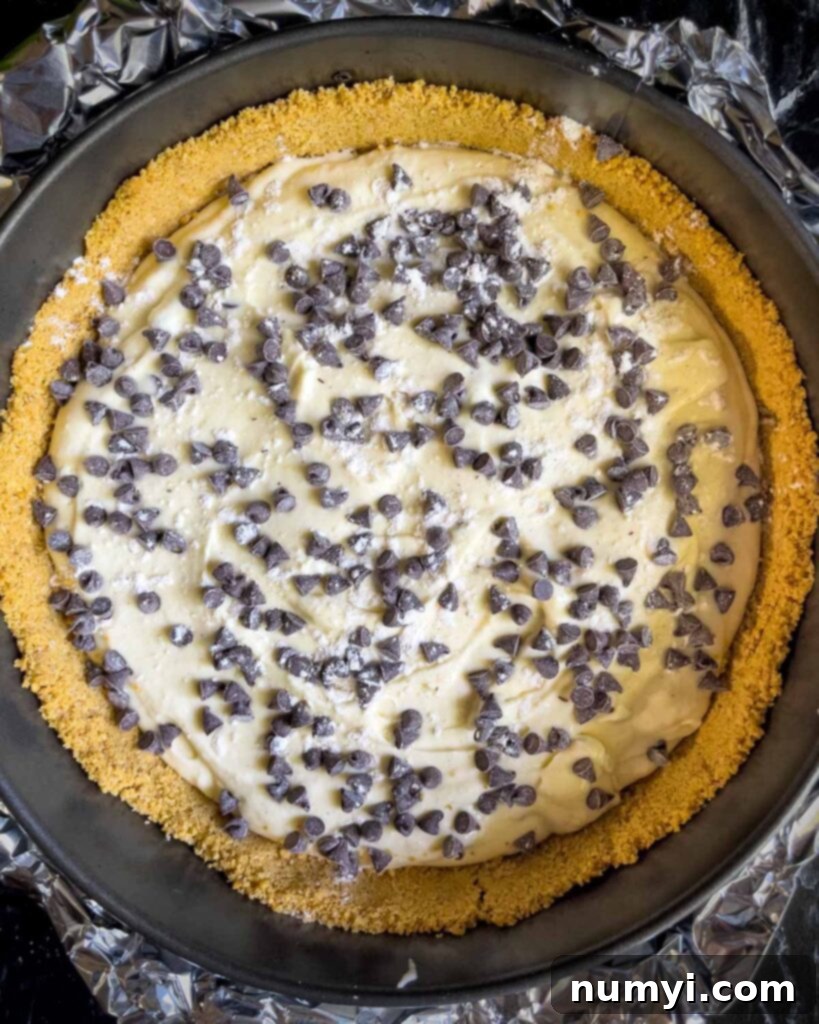
Assembling and Baking
Pour half of the prepared cheesecake batter over the cooled graham cracker crust in the springform pan and spread it out evenly with a spatula. Sprinkle another ¼ cup of the flour-coated chocolate chips over this layer of batter. Repeat this process with the remaining batter and the final ¼ cup of chocolate chips, creating beautifully layered chocolate throughout the cheesecake.
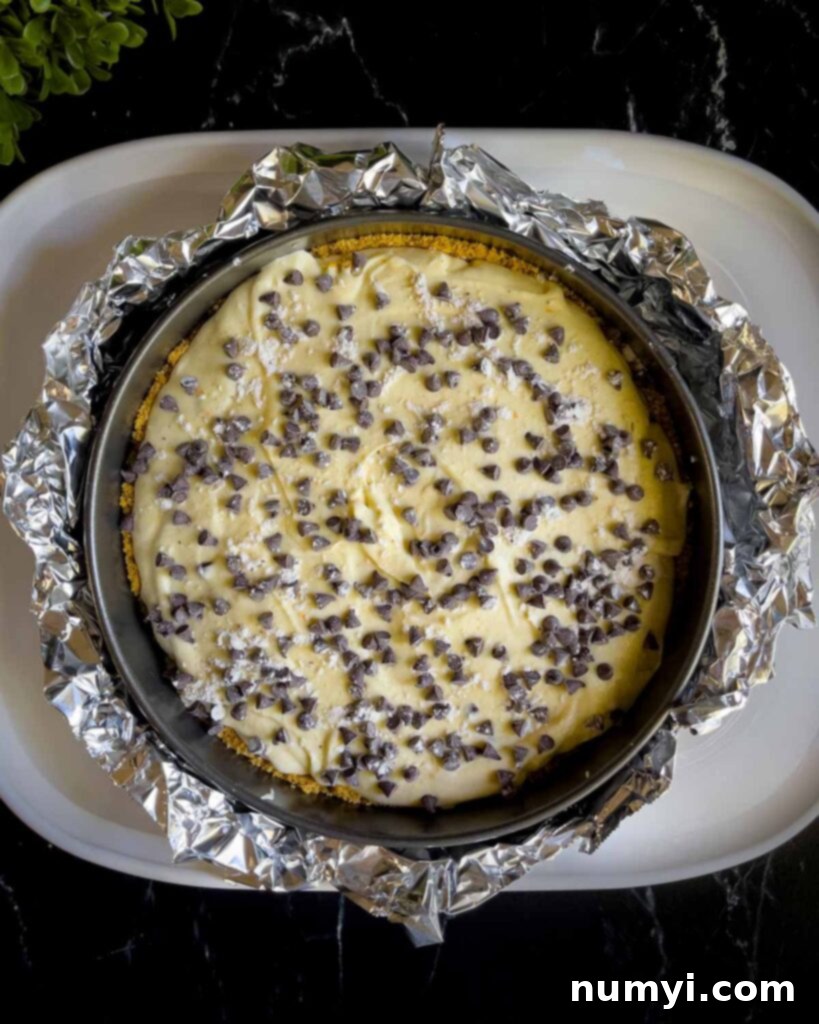

Carefully place the foil-wrapped springform pan into the center of the large deep roasting pan. Transfer the roasting pan with the cheesecake to the center rack of your preheated 325-degree F (160 degrees C) oven. Once it’s in the oven, slowly and cautiously pour boiling water into the roasting pan until the water level reaches approximately halfway up the sides of the springform pan. This water bath is crucial for ensuring even baking and preventing cracks in your cheesecake.
Bake the cannoli cheesecake for approximately 1 ½ hours. The cheesecake is done when the edges appear set and are a light golden brown, but the very center still has a slight jiggle. If you notice wave-like ripples when gently shaking the pan, it likely needs a little more time. Since oven temperatures can vary, begin checking your cheesecake around the 70-minute mark.
Once baked, turn off the oven. Crack the oven door open slightly and allow the cheesecake to cool slowly within the oven, still in its water bath, for one full hour. This gradual cooling process helps prevent sudden temperature changes that can cause cracks. As you crack the oven door, it’s also a great time to sprinkle a few more mini chocolate chips over the top for a final flourish.
After one hour, carefully remove the roasting pan from the oven. Then, gently lift the springform pan out of the water bath and transfer it to a wire rack to cool completely to room temperature. This can take several hours.
Once the cheesecake has reached room temperature, place a large paper towel over the top of the springform pan (this helps absorb any condensation) and then wrap the entire pan tightly in plastic wrap. Refrigerate the cheesecake for a minimum of 6 hours, but for the best flavor and texture, refrigerating it overnight is highly recommended. This chilling period allows the cheesecake to fully set and for the flavors to meld beautifully.
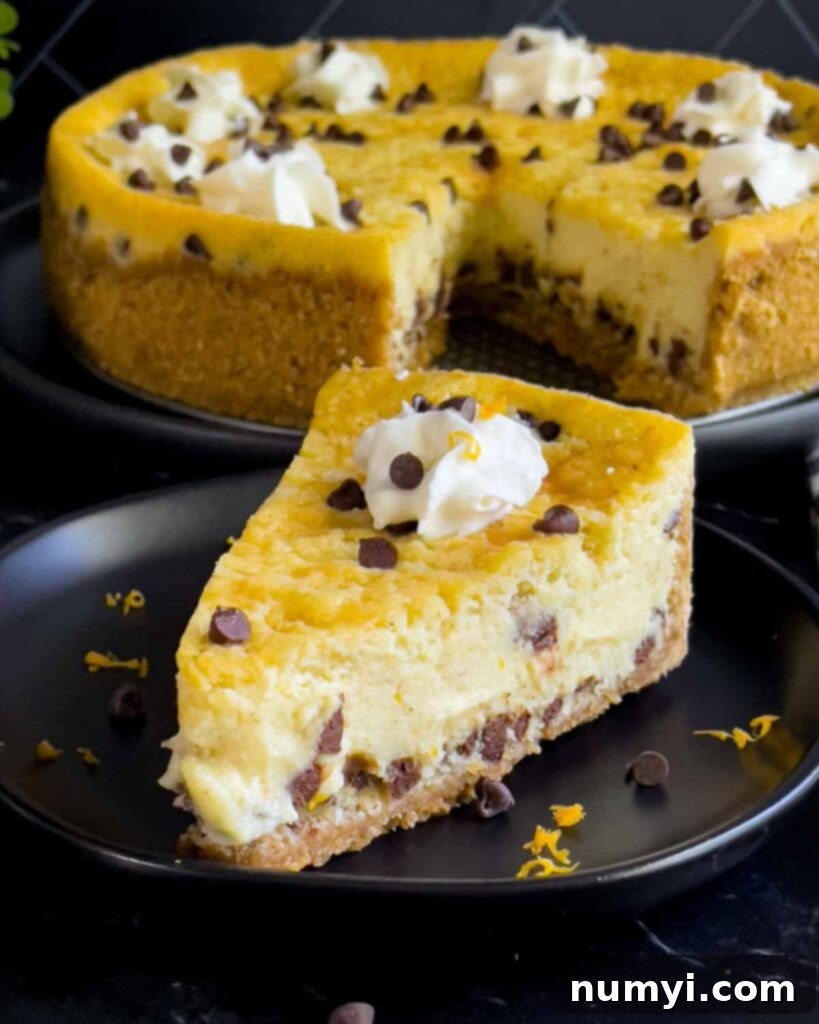
Expert Tips for the Perfect Cannoli Cheesecake
Achieving a flawless cannoli cheesecake is easy with these expert tips:
- Room Temperature Ingredients: This is fundamental for cheesecake success. Ensure your ricotta cheese, mascarpone cheese, and eggs are all at room temperature. Cold ingredients are harder to emulsify and mix, leading to a lumpy batter and a potentially unevenly baked cheesecake. Room temperature ingredients blend more smoothly, creating a uniform, creamy batter that bakes beautifully.
- Do Not Overmix: While mixing is essential, overmixing the cheesecake batter can incorporate too much air. This excess air expands during baking and then collapses as the cheesecake cools, often resulting in a sunken center and unsightly cracks. Mix just until ingredients are combined, then stop.
- Don’t Skip the Water Bath: The water bath (bain-marie) is your best friend when baking cheesecake. It creates a moist, even heat environment in the oven, which bakes the cheesecake gently and slowly. This gentle baking prevents the edges from cooking too quickly and helps distribute heat evenly, significantly reducing the risk of cracks and ensuring a silky-smooth texture. Always use boiling water, not cold, as cold water could drastically lower the oven temperature and affect baking time.
- Top Browning: This cheesecake’s top naturally develops a beautiful golden-brown hue. If you prefer a lighter top, or notice it browning too quickly, lightly tent the springform pan with aluminum foil after about 40 minutes to an hour of baking time. This acts as a shield, preventing further browning while the cheesecake continues to cook.
- Do Not Overbake: Overbaking is a common cause of dry, cracked cheesecakes. A cheesecake is perfectly done when the edges are visibly set, but the center still has a slight, delicate jiggle, much like a firm custard. It will continue to firm up considerably as it cools. If you observe distinct “ridges” or “waves” when you gently jiggle the pan, it indicates the center is still too liquid and needs more time. Trust the jiggle!
- Avoid Sudden Temperature Changes: Rapid temperature changes are a cheesecake’s enemy, often leading to cracking. Do not open the oven door unnecessarily while the cheesecake is baking. After baking, allow the cheesecake to cool very gradually by turning off the oven, cracking the door open, and letting it rest inside for one hour. This slow descent in temperature helps maintain its perfect structure.
- Refrigerating: When chilling your cooled cheesecake, place a large paper towel directly over the top of the springform pan before wrapping it tightly in plastic wrap. This clever trick absorbs any condensation that might form, preventing water droplets from dripping onto and potentially marring the beautiful top of your cheesecake.
- Chocolate Chips: To prevent those delicious mini chocolate chips from sinking to the bottom of your cheesecake during baking, ensure you use mini chocolate chips (their lighter weight helps). More importantly, toss them lightly in about 1 tablespoon of all-purpose flour before folding them into the filling. The flour creates a barrier that helps them suspend evenly throughout the batter.
Delicious Variations to Customize Your Cannoli Cheesecake
While this cannoli cheesecake recipe is perfect as is, you can easily customize it to suit your preferences or seasonal ingredients. Here are some delightful variations:
- Crust: We’re partial to a classic graham cracker crust for its buttery, subtly spiced flavor. However, feel free to experiment with other bases! You could use crushed waffle cones or sugar cones for a more pronounced “cannoli shell” flavor, though we’ve found these can sometimes become tough or sticky after baking. Crushed cannoli shells make a truly authentic base. For a more sophisticated twist, try a biscotti crust, which adds an elegant crunch and almond notes.
- Filling: For the most authentic taste and creamy texture, mascarpone and ricotta cheese are highly recommended. If you don’t have mascarpone, you can use regular cream cheese. However, be aware that substituting regular cream cheese will result in a different, tangier flavor profile and a slightly less rich texture compared to the traditional Italian version.
- Garnish: The garnish is where you can truly let your creativity shine! Classic choices include a dollop of fresh whipped cream and a generous sprinkle of extra mini chocolate chips. For added elegance and crunch, consider chopped pistachios – their vibrant green color and nutty flavor are fantastic with cannoli. A simple dusting of powdered sugar offers a delicate finish. You could also add candied orange peel, finely chopped candied fruit, or even a drizzle of dark chocolate ganache for extra indulgence.
Frequently Asked Questions About Cannoli Cheesecake
Chocolate chips tend to sink in cheesecake batter because they are denser than the batter itself. To prevent this, there are a couple of effective strategies. First, opt for smaller, lighter mini chocolate chips, as they are less prone to sinking. Second, and most crucially, lightly toss the chocolate chips in about 1 tablespoon of all-purpose flour before folding them into the batter. This thin coating of flour creates a non-stick barrier that helps the chips suspend more evenly throughout the cheesecake as it bakes, rather than collecting at the bottom.
Proper storage is key to maintaining the freshness and deliciousness of your cannoli cheesecake. Once the cheesecake has completely cooled to room temperature, cover it tightly. We recommend placing a large paper towel over the top of the cheesecake (still in its springform pan) before wrapping the entire pan securely with plastic wrap. The paper towel will absorb any condensation, preventing it from making the top of your cheesecake soggy. Store the covered cheesecake in the refrigerator for up to 4 days. Always keep it chilled to preserve its creamy texture and prevent spoilage.
Yes, you absolutely can freeze mascarpone and ricotta cheesecake to enjoy later! To freeze slices, we recommend flash freezing them first. Place individual slices on a parchment-lined baking sheet and freeze for about 2 hours, or until solid. Once frozen, transfer the solid slices to a freezer-safe airtight container or wrap them individually in plastic wrap and then foil to prevent freezer burn. They can be frozen for up to 2 months for optimal quality. While the taste remains amazing, be aware that freezing can sometimes alter the texture slightly, making it a bit more mealy upon thawing. Thaw frozen cheesecake overnight in the refrigerator before serving.
Explore More Delectable Cheesecake Creations
Carrot Cake Cheesecake
Chocolate Covered Cheesecake Bites
Lemon Cheesecake Shortbread Bars
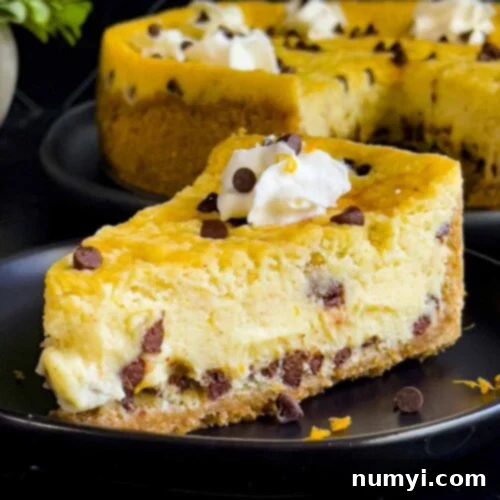
Cannoli Cheesecake Recipe
Print
Pin
Rate
Ingredients
Crust
- 1 3/4 cup Graham cracker crumbs about 15 crackers
- 1/4 tsp Ground cinnamon
- 1/8 tsp Salt
- 1/3 cup Unsalted butter melted
Cheesecake Filling
- 15 ounces Whole milk ricotta cheese drained overnight and room temperature
- 16 ounces Mascarpone cheese room temperature
- 1 1/4 cup Granulated sugar
- 3 tbsp All-purpose flour divided
- 1/4 tsp Ground cinnamon
- 1 tsp Fresh orange zest
- 1 1/2 tsp Vanilla extract
- 1/2 tsp Kosher salt
- 4 large Eggs room temperature
- 3/4 cup Mini chocolate chips plus more for garnish
Instructions
Crust
-
Preheat the oven to 350 degrees F (175 C). Spray a 9-inch springform pan with nonstick cooking spray. Then wrap the bottom and sides of the springform pan in a double layer of heavy-duty aluminum foil to protect it during the water bath.
-
In a medium bowl, combine the graham cracker crumbs, ground cinnamon, kosher salt, and melted butter. Mix these ingredients thoroughly until well combined and the crumbs are moistened.1 3/4 cup Graham cracker crumbs, 1/4 tsp Ground cinnamon, 1/8 tsp Salt, 1/3 cup Unsalted butter
-
Press the mixture firmly and evenly into the bottom of the prepared springform pan. Bake for 10 minutes, then remove from the oven and allow to cool completely on a wire rack while preparing the filling.
-
Reduce the oven temperature to 325 degrees F (160 C).
-
Ensure you have a large roasting pan ready that will accommodate the springform pan. This will be used for the water bath to ensure even baking; the springform should fit in the middle and not touch the outer pan’s sides.
Cheesecake Filling
-
In a large bowl, using an electric mixer, beat the room temperature mascarpone cheese for about 10 seconds until slightly softened. Add the room temperature, well-drained ricotta cheese and beat on medium speed until well combined and smooth, scraping down the sides as needed.16 ounces Mascarpone cheese, 15 ounces Whole milk ricotta cheese
-
Add the granulated sugar, vanilla extract, all-purpose flour (2 tbsp from the total 3 tbsp), ground cinnamon, fresh orange zest, and kosher salt. Beat on medium-low speed until well combined and smooth, scraping down the sides of the bowl as needed to incorporate all ingredients.1 1/4 cup Granulated sugar, 3 tbsp All-purpose flour, 1/4 tsp Ground cinnamon, 1 tsp Fresh orange zest, 1 1/2 tsp Vanilla extract, 1/2 tsp Kosher salt
-
Beat the eggs in one at a time, mixing until just combined after each addition. Do not overmix. Toss the mini chocolate chips with the remaining 1 tablespoon of all-purpose flour. Gently fold in 1/4 cup of the flour-coated chocolate chips into the batter.4 large Eggs, 3/4 cup Mini chocolate chips
-
Pour half of the cheesecake batter over the cooled crust and spread it out evenly. Sprinkle 1/4 cup of the flour-coated chocolate chips on top. Repeat with the remaining batter and remaining chocolate chips for layering.
-
Place the springform pan (in its foil wrap) into the large roasting pan. Carefully place this assembly into the center of the preheated oven. Slowly pour boiling water into the roasting pan until the water is halfway up the sides of the springform pan.
-
Bake the cannoli cheesecake for 1 1/2 hours, or until the edges are set and lightly golden brown, but the center still has a slight jiggle. Check the cheesecake after about 70 minutes, as oven temperatures can vary.
-
Turn the oven off. Crack the oven door open about an inch and allow the cheesecake to slowly cool in the oven, still in the water bath, for one hour. At this stage, you may sprinkle a few more chocolate chips over the top of the cheesecake for extra garnish.
-
Remove the roasting pan from the oven, then carefully lift the springform pan out of the water bath and transfer it to a wire rack to cool completely to room temperature. This can take several hours.
Once the cheesecake is cooled completely, place a large paper towel over the top of the springform pan, then wrap it tightly in plastic wrap. Refrigerate for at least 6 hours, but for the best flavor and texture, refrigerating overnight is highly recommended.
Notes
Top Browning – The top of this cheesecake naturally tends to turn a lovely golden brown. If you prefer a lighter top, or if it’s browning too quickly, gently tent it with aluminum foil after about 40 minutes of cooking time to slow down the browning process.
Do not overbake – The cheesecake is perfectly done when its edges are set and firm, but the very center still has a slight, delicate jiggle. It will continue to firm up as it cools. If you notice distinct ridges (wave-like patterns) when gently jiggling the pan, it indicates the center is still too liquid and requires a bit more baking time.
Refrigerating – To prevent condensation from forming and dripping onto the top of your beautifully crafted cheesecake, place a large paper towel directly over the top of the springform pan before wrapping it tightly in plastic wrap for refrigeration.
